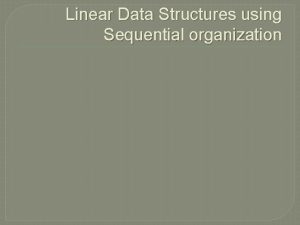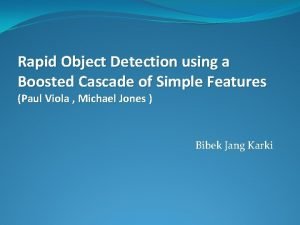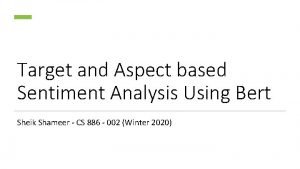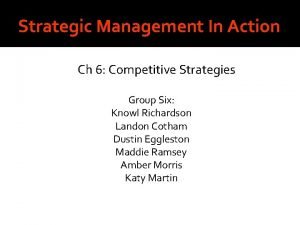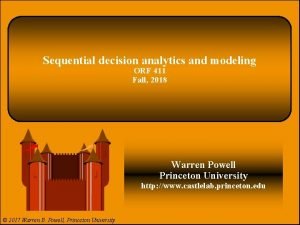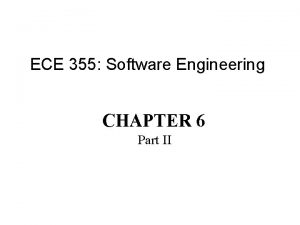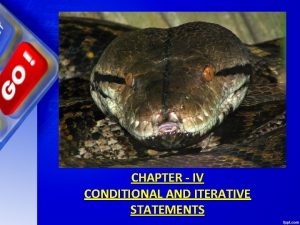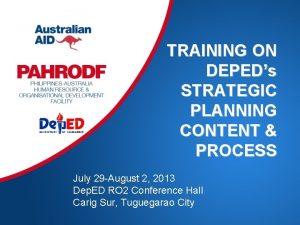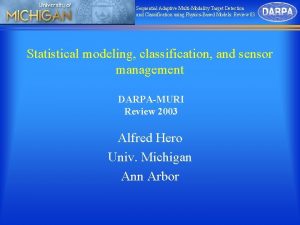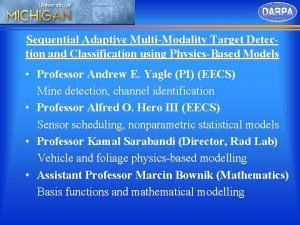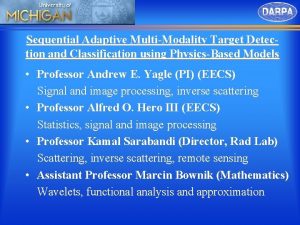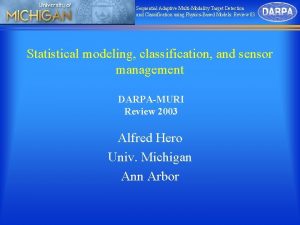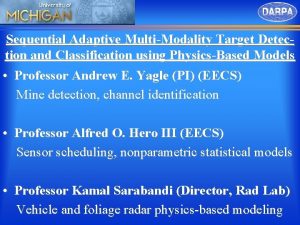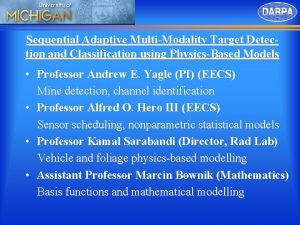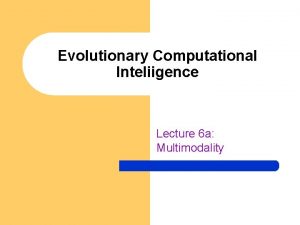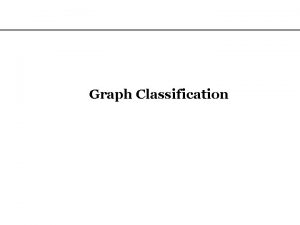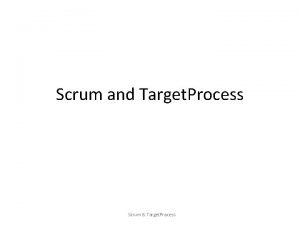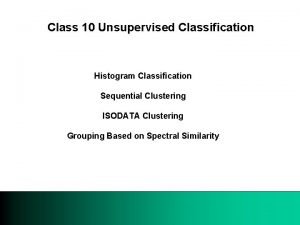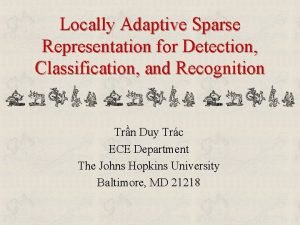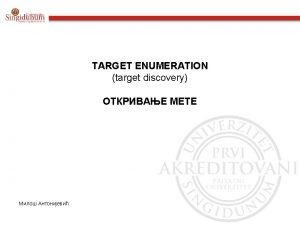Sequential Adaptive MultiModality Target Detection and Classification using


























- Slides: 26

Sequential Adaptive Multi-Modality Target Detection and Classification using Physics-Based Models • Professor Andrew E. Yagle (PI) (EECS) Mine detection, channel identification • Professor Alfred O. Hero III (EECS) Sensor scheduling, nonparametric statistical models • Professor Kamal Sarabandi (Director, Rad Lab) Vehicle and foliage radar physics-based modeling


Redu ced M SM Da ta ted ula ta Performance Da Sim al Sc m ena od r els ios /S odels Sc m ena od ri els os /S en so r tu TUT Ac en s or o M d uce d e R dels Matrix Hybrid UXO simulated/real data Environment Modification

Research Project Objectives 1. Develop physics-based and statistical models for radar scattering from vehicles under foliage; 2. Develop physics-based and statistical models for GPR and EMI responses of buried land mines; 3. Develop statistical algorithms for detection and sensor management for multiple sensor modalities; 4. Insert physics-based models into statistical sensor management and detection multi-modal algorithms; 5. Evaluate the resulting procedure on realistic models (physics-based and statistical) and on real data.

1. Physics-based models for vehicles under foliage • Sarabandi: Developed very realistic models for radar scattering from vehicles under foliage. Significance: Use in Monte Carlo simulations to develop statistical models to be inserted into sensor management and detection algorithms. Significance: Evaluation of resulting algorithms. • Hero: Non-parametric model for scattered field. Significance: Monte Carlo takes forever. So developed statistical interpolation algorithm.

2. Physics-Based Models for Land Mines Yagle: Applied time-reversal imaging to GPR. Significance: Basic mine detection algorithm. Yagle: Developed metal detector model for mine detection and decay rate to distinguish Fe and Al. Significance: Quick way to develop multiple modalities and evaluate them on real test data. Significance: Insert these into Hero’s statistical sensor scheduling and detection algorithms.

3. Statistical Sensor Management and Detection • Hero: Myopic and non-myopic multi-sensor management for detection and tracking. Significance: Greatly reduces computation. Demonstrated tracking of dozens of actual targets. • Hero: Aggregation strategy for objective function maximization for distributed sensors. Significance: Easier to find global maximum for optimal sensor scheduling and deployment.

4. Inserting Physics-Based Statistical Models into Statistical Sensor Management Algorithms • Sarabandi, Hero, Yagle: In Years #3 and #4 we will insert statistical models developed using Monte Carlo simulations on realistic physics-based models into statistical sensor management and detection algorithms. Significance: This is the heart of our MURI, where payoff comes: Rigorous statistical algorithms for sensor management based on realistic physics-based and statistical models.

5. Evaluation of Algorithms We Have Developed • Sarabandi: Using realistic physics-based models we have now developed for vehicles under foliage, we can now evaluate algorithms in a wide variety of physical scenarios in which ground truth can be set. • Real data also to be used, but real and multi-modal data only available for limited set of scenarios. • Hero: Statistical algorithms used to evaluate the performance of sensor management algorithms. • Yagle: Similarly for mine detection problem.

New. Research Project Objectives • Develop physics-based and statistical models for radar scattering from vehicles under foliage; • Develop physics-based and statistical models for GPR and EMI responses of buried land mines; • Develop statistical algorithms for detection and sensor management for multiple sensor modalities; • Insert physics-based models into statistical sensor management and detection multi-modal algorithms; • Evaluate the resulting procedure on realistic models (physics-based and statistical) and on real data.

Old Research Project Objectives • Develop overall algorithm for sequential detection, sensor management & selection • Develop physics-based models for mines and vehicles; statistical models from them. • Simplify physics-based models using functional-analysis-based approximation • Evaluate the resulting procedure on realistic models (statistical simulations) and real data

Changes to Original Program Objectives: • • • PROJECT OBJECTIVES DROPPED: Optimal basis function representations Basis-function-based inverse scattering Underground structures PROJECT OBJECTIVES ADDED: More specific about physics-based models leading to statistical models, to be inserted in statistical sensor management algorithms

ALGORITHM DEVELOPMENT SENSOR MANAGEMENT VEHICLE DETECTION FOLIAGE MINE DETECTION TANK GPR FREQ. POLAR FREQ. . METAL DETECTOR

Overall Algorithm: Overview Target detector/ classifier

GOAL #1: ACCOMPLISHMENTS I • Performed phenomenological studies of: (a) physics-based clutter models (b) physics-based target models Significance: Basic understanding of effects is vital for interpreting results. These proved very useful in developing the statistical models of scattered fields.

GOAL #1: ACCOMPLISHMENTS II • New results: Target-clutter interaction; Multiple scattering from needle clusters; Closed-form solution for scattering from a disk of arbitrary shape. • Developed time-reversal method for foliage camouflaged target detection. Significance: This is one of the physicsbased models for detection (project title).

GOAL #1: ACCOMPLISHMENTS III • Developing iterative frequency-correlation based forest radar channel identification; New approach for attenuation estimation. Significance: Procedure for deconvolving effects of propagation through foliage. • Developing iterative physical optics approach to account for foliage shadowing. Significance: Greatly reduces computation

GOAL #2: ACCOMPLISHMENTS I • Developed mine detection algorithm from SAR GPR using range migration imaging (with Jay Marble). Significance: Physics-based algorithm for imaging mines from ground-penetrating radar (project title). • Developed 2 D and 3 D blind deconvolution algorithms for radar channel identification (with Siddharth Shah). Significance: Apply to blind deconvolution of channel propagation effects for mines, and perhaps for foliage.

GOAL #2: ACCOMPLISHMENTS II • Developed “hyperbola-flattening transform” algorithm for feature detection in GPR data. Significance: Preliminary detection stage using less computation than range-migration imaging • Working on material discrimination using decay rates from magnetometer (metal detector) data. Significance: Multi-modal mine detection.

GOAL #3: ACCOMPLISHMENTS I • Developed non-parametric statistical modelling of scattered fields using Markov random fields. Significance: Can model scattered fields from a few observations, extrapolating the rest. This saves much time in Monte Carlo statistical model development. • Developed target model reduction technique. Significance: Can model vehicles using a lower dimensional manifold, simplifying detection.

GOAL #3: ACCOMPLISHMENTS II • Developed myopic distributed multi-sensor multilook detection and tracking sensor management algorithms using Renyi divergence. Significance: Optimal sensor scheduling too hard when many targets and sensors present. Particle filtering + Renyi-divergence-based scheduling reduces complexity. Tracking of dozens of actual targets was demonstrated.

GOAL #3: ACCOMPLISHMENTS III • Developing non-myopic distributed multi-sensor multi-look detection and tracking sensor management algorithms using queue learning. Significance: Can develop quantification of the performance-vs-complexity tradeoff issue. • Developing aggregation strategies for distributed sensors and quantified performance tradeoffs. Significance: Allows fast computation of maxima of objective functions; these dictate strategies.

Synergistic Activities: Hero General Dynamics (formerly Veridian, ERIM): C. Kreucher: sensor management & scheduling K. Kastella: sensor management J. Ackenhusen: mine detection ARL: NAS-SED review panel member N. Patwari (student) summer internship G. Shih (student) summer internship

Synergistic Activities: Sarabandi General Dynamics: John Ackenhusen BAE: Norm Byer FCS COMMUNICATIONS: Jim Freibersiser (DARPA PM) Barry Perlman (CECOM) ARL: Ed Burke (mm wave), Brian Sadler, Bruce Wallace

Synergistic Activities: Yagle General Dynamics (formerly Veridian, ERIM): Jay Marble, student (ARO mine research) Brian Fischer, student (Low RCS material design) Chris Wackerman, former Ph. D. student

SEQUENTIAL ADAPTIVE MULTI-MODALITY TARGET DETECTION AND CLASSIFICATION USING PHYSICS-BASED MODELS (PICTURE) APPROACH • Develop realistic physics-based models; • Perform statistical simulations to obtain distributions of measured scattered fields; • Develop sensor scheduling and detection algorithms using these statistical models; • Evaluate algorithms using statistical measures; • Apply algorithms to real multi-modal data. ARMY COLLABORATIONS • Army Night Vision Lab (GPR & IR mine field data). OBJECTIVES • Develop algorithms for detection of landmines and tanks under trees using radar and IR sensors; • Develop data-adaptive algorithms for sensor scheduling and multi-modal sequential detection; • Evaluate the algorithms using Monte Carlo type simulations on realistic models, and on real data. ARMY RELEVANCE • Detection of landmines and tanks under trees has obvious Army relevance ACCOMPLISHMENTS • Phenomenological studies of radar clutter and target+clutter using realistic physics-based models; • Developed non-parametric MRF models for these; • Developed myopic sequential adaptive sensor management algorithm for tracking problems; • Developed migration (time-reversal) algorithm for imaging land mines and evaluated on real GPR data. TRANSITION TO ARMY/ INDUSTRY • None yet.
 Primary target market and secondary target market
Primary target market and secondary target market Sequential data structure example
Sequential data structure example Linear data structure using sequential organization
Linear data structure using sequential organization Rapid object detection using a boosted cascade
Rapid object detection using a boosted cascade Speed detection of moving vehicle
Speed detection of moving vehicle Classification of hotels based on target market
Classification of hotels based on target market Sentihood
Sentihood Main/subroutine architecture
Main/subroutine architecture Abilities for adaptive and positive behavior
Abilities for adaptive and positive behavior Miles and snow's adaptive strategies
Miles and snow's adaptive strategies Adaptive and corrective maintenance
Adaptive and corrective maintenance Tonsils
Tonsils Using system using system.collections.generic
Using system using system.collections.generic Unit 25 special refrigeration system components
Unit 25 special refrigeration system components Classification of data in statistics
Classification of data in statistics Sequential decision analytics
Sequential decision analytics Java ee platform
Java ee platform Differentiate between conditional and iterative statements
Differentiate between conditional and iterative statements The main drawback of index sequential file organisation is
The main drawback of index sequential file organisation is Differences between sequential and event-driven programming
Differences between sequential and event-driven programming Sequential vs. synchronic
Sequential vs. synchronic Batch sequential vs pipe and filter
Batch sequential vs pipe and filter Deped strategic planning
Deped strategic planning Rational sequential and analytical strategizing
Rational sequential and analytical strategizing Example of simultaneous integration
Example of simultaneous integration Mealy and moore sequential circuits
Mealy and moore sequential circuits Sequential and parallel blocks in verilog
Sequential and parallel blocks in verilog


